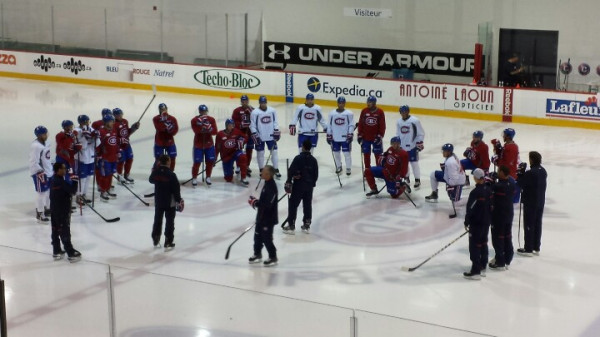
State of the Habs is a 12-part feature series where I’ll break down the Habs’ season into 4-game chunks and look at players who are under- or over-performing during that time, while commenting on issues surrounding the team.
See Previous Segments:
Part 1 (Games 1-4: 3-1-0, “The Boys are Back in Town”)
Part 2 (Games 5-8: 3-1-0, “Rinse and Repeat”)
Part 3 (Games 9-12: 1-2-1, “The Plot Thickens”)
Part 4 (Games 13-16: 4-0-0, “Perfection”)
Part 5 (Games 17-20: 2-0-2, “And the Streak Goes On”)
Part 6 (Games 21-24: 2-1-1, “No Defense, No Problem”)
Overview – 4 Game Segment 7/12 (Games 25-28)
| Season | Last Four Games | |
| Record | 19-5-4 | 4-0-0 |
| Goal Differential | +20 | +6 |
| Leading Scorer | Ryder (8-15-23) | Subban (1-4-5) |
| Hot (L4 GP) | Plekanec (2-3-5) | |
| Cold (L4 GP) | Desharnais (1-0-1) | |
By Dan Kramer, Senior Writer, All Habs Hockey Magazine
TORONTO, ON – Life isn’t easy at the top.
This may be what the Montreal Canadiens are realizing as they look at the standings this morning and see that – despite having just completed the second perfect four-game stretch of their season – they have been bumped out of first place in the NHL’s Eastern Conference.
The most recent segment saw the team buck the troubling trend of disastrous second periods in a dominant victory over the Florida Panthers, only to require a compelling third period comeback to overcome a nightmarish middle stanza against the Tampa Bay Lightning the next night.
The rest of the week presented tougher challenges, with the Habs ultimately prevailing with one-goal victories against clubs in the playoff mix – Ottawa and New Jersey. Carey Price earned a shootout win against the former and then turned in one of his better performances of the season against the latter on a night where his side was outshot 33-22, including 18-9 in the third period alone.
That the team is now an astounding 13-1-3 since the 6-0 drubbing they suffered at the hands of the Toronto Maple Leafs over a month ago is rendered even more impressive as the club deals with multiple injuries for really the first time this year. While Michael Ryder – replaced by Mike Blunden for the game against New Jersey – returned to practice on his usual line Monday, Brandon Prust, Rene Bourque, and Yannick Weber all skated on the other sheet of ice in Brossard, not yet ready to join their teammates. Raphael Diaz, meanwhile, continues to work out in the gym on his own, his concussion symptoms not allowing him to take to the ice.
Having built a nice point cushion over the 9th and 10th place New York Islanders and Rangers, the Habs are in a nice position where they don’t have to try to rush anyone back into the line-up. They can allow the likes of Bourque, Prust, and Diaz to take their time to properly heal in full with the aim of having as complete a roster as possible for the final stretch and a playoff drive.
In the meanwhile, the growing sick bay hasn’t slowed the team down (via NHL.com):
Surpassing Expectations
The team’s recent injuries have meant a slew of call-ups from Montreal’s AHL affiliate, the Hamilton Bulldogs, and for the most part, they have fit right in, playing parts in the team’s successes. Understandably, expectations of players being called-up from a last place AHL squad needed to be tempered, but yet all receive passing grades for their contributions.

Wanting more size and toughness than Tomas Kaberle brings to the blueline, the team first turned to Greg Pateryn, as the 6’2″ 22-year old pro rookie was playing his best hockey of the season on Hamilton’s top pair alongside the more offensive Nathan Beaulieu. Pateryn received only limited minutes in the three games in which he appeared, and though he looked nervous at times – particularly in his final outing – accomplished his job relatively successfully, maintaining an even plus-minus rating and compensating for his defense partner Francis Bouillon‘s small stature. The team would then opt to audition an even larger partner for Bouillon by returning Pateryn to the Bulldogs and calling up 2010 first round selection Jarred Tinordi, whose debut was more noticeable than Pateryn’s. Tinordi’s first NHL game against New Jersey wasn’t perfect, but he did finish the night at plus-2 in 14:48 of ice time, and collected an assist on Tomas Plekanec‘s game-winning deflection goal. It will be worth watching if he can continue to play at such a level and clean up his work in his own end to earn a prolonged stay with the big club, with a positive indication that the coach trusts the rookie being that he was still taking regular shifts in a tight game’s third period. Even if he is sent down, Tinordi will battle the likes of Pateryn for a full-time job out of camp in the Fall.
At forward, the team turned to Gabriel Dumont to replace Brandon Prust, and then Mike Blunden once Michael Ryder had to skip the most recent game against the Devils, both deserving call-ups as they have been Hamilton’s best and most consistent forwards this season. Dumont has stuck in Prust’s spot with Alex Galchenyuk and Lars Eller, working tirelessly and constantly in the face of opposing players, while also picking up his first NHL point against Ottawa. Blunden, who was a favourite of interim coach Randy Cunneyworth with the Canadiens last season, stepped on to the fourth line and was standing all over Johan Hedberg in Saturday’s first period, providing the needed screen for Colby Armstrong to fire his first as a Canadien past the Devils’s netminder.
As well as Dumont has fit in, a ton of credit must go to his linemate Lars Eller who continues to show that he has a long and promising career ahead of him. He has hands that can take over shifts entirely, and while his offensive totals for this segment read only a single point, he has taken his defensive game to new heights, taking the body more frequently, blocking shots, and generally being all over the puck. It is Eller’s play that is making the difference in providing true depth to the Montreal attack.
Even when he was producing points, it took Michael Ryder a few games to fit in with his new old (but really new) team. Ryder was much better over the first three games of this last stretch (before missing the fourth with a lower body injury that also saw him sit out most of the third’s second period), tying for the team lead with five points on the week. Despite playing his less comfortable left wing, he has found a home with veterans Tomas Plekanec and Brian Gionta, re-igniting the offensive games of the pair who had been slumping since Rene Bourque suffered his concussion (the two have also benefited from reduced minutes, which seems to have them playing with more energy when on the ice). It should be noted that Ryder’s playoff numbers historically are far better than Erik Cole‘s, so we may still yet be weeks away from reaping the best rewards that deal has to offer for the current season. For those keeping track, Cole has one goal and is a minus-2 in seven games in Dallas, now at just seven points in 26 games on the season, compared to Ryder who has scored nine points in the eight games he’s played since the trade alone.
Finally, it’s impossible to talk about impressive performers without mentioning P.K. Subban, who is deserving of the Norris buzz that is beginning to surround him. There should no longer be any lingering doubts that he is the team’s true No. 1 on the blueline, and though Andrei Markov remains an important part of this season’s back end, the minutes are slowly transitioning to the younger dynamic rearguard. Of note is that the team’s powerplay seems as reliant on Subban as ever, as his booming pointshot seems to be the only consistent threat, resulting in his collecting a point on all four powerplay markers the team scored during this four-game stretch.
The Letdowns
With different players and lines stepping up every night, there are no real goats to pinpoint on the Montreal roster over the past segment. Thus, instead, we can look at the other big news over the past week, being the contract extension awarded to David Desharnais.

It’s easy to like David Desharnais. Everyone loves a good underdog story – a player who defies the odds and competes at the highest level despite his physical limitations – particularly when the subject paid his dues in taking the long route to success. And all this without mentioning he’s a local Quebec product, making him all the more relatable to the fiercely proud Hab supporter base.
There’s no denying he’s gifted offensively, boasting quick mitts that allow him to work around defenders and find teammates at will in the offensive zone. The rest of his game leaves much to be desired, as he frequently struggles in the face-off circle and is far from dependable defensively. Oh, and he’s 5’7″. There’s that too.
It is the balance of positives and negatives that make $3.5M pretty much on the nose cap hit for the hardworking pivot. If he can produce near his last season’s totals again, it even becomes quite a bargain. So then why do I categorize this deal as a letdown?
Permit me to answer a question with a question. “Why now?” There was absolutely no sense of urgency to re-sign Desharnais, particularly to commit to him for a four-year term. Though his contract was to be up at season’s end, he was heading for restricted free agency with a bargain basement qualifying offer, so there was no risk of losing him for no return. The only reason to give him this kind of a contract NOW – before waiting to explore all other options – is the identification by management that he represents a core part of the team’s structure moving forward. And THAT, to me, is the crux of the letdown. Why not see what’s out there come deadline day? Why not see who may be on the trade market at the draft? Or who makes it to UFA status this summer and next?
The Canadiens have been talking about a need to get bigger – particularly at the centre position – for years. It was a problem of the old regime led by Saku Koivu that continued over with the Brian Giontas, Scott Gomezes, and Mike Cammalleris of the new guard. The below-average-sized Tomas Plekanec is on a long-term deal with the Canadiens. One would expect, then, that the team may look to bring in a bigger offensive centre from outside the organization to compliment him in the top-6. No longer is there room for such an acquisition.
What does it say about the budding top-6 centres – with better size – in Lars Eller and Alex Galchenyuk? Unless it is Desharnais that is eventually shifted, it means one is likely to develop at wing for the next four years. Even if the team rolls more of a top nine offensively than a top six, splitting the minutes fairly evenly, you’re still stuck with four centres for three trios. It may be a good problem to have such depth at times, but it also complicates the development of a young star like Galchenyuk who is likely to be shifted around more than one would normally hope.
And what of Desharnais’s chemistry with Max Pacioretty? Good as it may be, with or without Desharnais, Pacioretty has emerged as a true No. 1 left winger. Desharnais, meanwhile, has been dependent on a big, power forward wing – something the team does not possess in abundance – to clear room for him to work his magic. While the nightly minutes may fall as they will, this means Desharnais is your first line offensive centre until proven otherwise. Well, either that or your best left winger is being wasted to compensate for a player the team might have upgraded, even internally through the natural progression of youth.
When a deal like this is signed, fans can only hope for the best, but at age 26, it isn’t a foregone conclusion that Desharnais still has better days ahead of him. As a positive, it may provide some cost and roster certainty for Marc Bergevin, dictating to an extent the kind of players he must now seek out to complete a balanced roster and the budget he’ll have remaining to do so.
The Road Ahead
Segment eight begins with what should theoretically be an easier week for the Canadiens with three games against teams currently not a part of the East’s top eight. Still, the opponents can’t be taken lightly, as the Habs have both a win and a loss against the Sabres (who they’ll play twice) and are 0-1-1 against the New York Islanders, with the team hoping to avenge that regulation loss – their only such defeat in the past 17 games – Thursday night.
The segment concludes with the first half of a back-to-back, on the road in Pittsburgh, which depending on how the week up until then plays out, could very well be a battle for the Eastern Conference lead.
It is hopeful that by the time the back-to-back rolls around, the Canadiens may get some of their injured players back into the line-up, with Brandon Prust likely being closest (since concussions – the cases of Rene Bourque and Raphael Diaz – are very difficult to predict). In the interim, to maintain the team’s current pace, the current players must work to improve the weakest spot in their game up till now, being the penalty kill.
The Canadiens currently rank 19th in the league with a 79.8% efficiency, and though it is interestingly still better than that of either Pittsburgh (20th) or Anaheim (26th), it is an area to be shored up prior to any post-season run. The passive diamond the team has settled into as the season has worn on is proving ineffective. For it to work, players must be well-positioned at all times in covering all open passing lanes, something the team has struggled to do. The team should have the personnel in place to be better than they are when a man down, so they must either compensate for lapses in coverage by switching to a more aggressive style, or seek reinforcements more suited to the game plan they’ve decided to enforce.
Whatever they choose to do, the team has provided fans with enough excitement to make the horrible memories of last season seem a thing of the distant past. With just seven games remaining between now and the trade deadline, we’ll soon have a clearer picture on just how Marc Bergevin sees the rest of the season playing out.
Three Stars – Seventh Twelfth
1. Tomas Plekanec
2. P.K. Subban
3. Michael Ryder
Three Stars – Standings through 7/12 segments
(three points for being named first star, two for second, one for third)
1. P.K. Subban – 8
1. Tomas Plekanec – 8
3. Alex Galchenyuk – 4
3. Max Pacioretty – 4
3. Lars Eller – 4
6. Andrei Markov – 3
7. Carey Price – 2
7. Peter Budaj – 2
7. Brian Gionta – 2
7. Rene Bourque – 2
7. David Desharnais – 2
12. Raphael Diaz – 1
12. Brandon Prust – 1
12. Michael Ryder – 1








![Prospect Report: Habs Development Camp Testing [GALLERY]](https://habshockeyreport.com/wp-content/uploads/2014/07/IMG_2897.jpg)

![Habs Western Road Trip in Pictures [GALLERY]](https://habshockeyreport.com/wp-content/uploads/2014/03/476898185_slide.jpg)
Comments are closed.